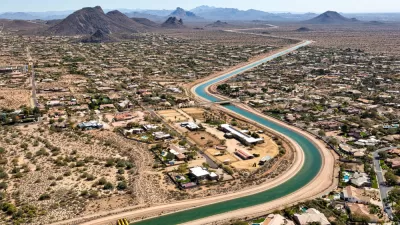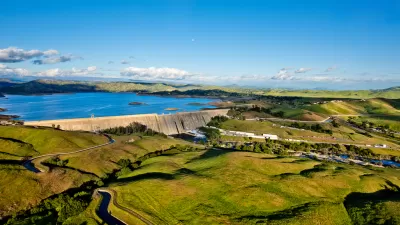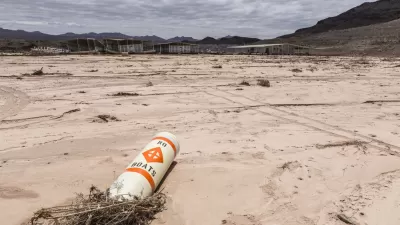A recent article details the rapid growth, evaporating surface storage capacity, and manicured lawns worsening drought conditions in Texas (no, not California).
Writing for Next City, Sara Goodyear details the facts and figures behind the under-reported story of Texas’ drought—which is approaching catastrophic levels in some parts of the state. “The drought map for the state of Texas from April 8 of this year isn’t pretty. As of the end of March, 67 percent of the state — up from 46 percent four months ago — suffered from moderate or worse drought conditions, according to the Texas Water Development Board. Twenty-five percent of the state is in ‘extreme’ drought or worse, and rainfall has been scant over the last 90 days.”
The drought has reduced levels at some of the reservoirs in the state to less than ten percent capacity. Adds Goodyear: “Not only the reservoirs are drying up. Groundwater levels are also on a downward trajectory in many parts of the state, as are stream flows — although reservoirs are particularly vulnerable because of evaporation.”
In an effort to be proactive about the drought, voters recent authorized $2 billion in water-related infrastructure spending to deal with the drought. But critics say the spending will neglect fundamental problems with the state’s management of its water supply. The first project to come online of the drought, for instance, is a surface storage facility that will send water to a suburb of the notoriously water inefficient Dallas.
Given the state’s quick population growth, Goodyear expresses concern that “the conflict between rural and urban water interests is bound to intensify if the drought continues.”
FULL STORY: To Deal With Drought, Texas Needs to Manage Growth

Trump Administration Could Effectively End Housing Voucher Program
Federal officials are eyeing major cuts to the Section 8 program that helps millions of low-income households pay rent.

Planetizen Federal Action Tracker
A weekly monitor of how Trump’s orders and actions are impacting planners and planning in America.

Ken Jennings Launches Transit Web Series
The Jeopardy champ wants you to ride public transit.

Tackling Soil Contamination With Nature-Based Solutions
Los Angeles County residents and experts are turning to nature-based methods like bioremediation to address long-standing and fire-exacerbated soil contamination without resorting to costly and disruptive removal.

Rebuilding Smarter: How LA County Is Guiding Fire-Ravaged Communities Toward Resilience
Los Angeles County is leading a coordinated effort to help fire-impacted communities rebuild with resilience by providing recovery resources, promoting fire-wise design, and aligning reconstruction with broader sustainability and climate goals.

When Borders Blur: Regional Collaboration in Action
As regional challenges outgrow city boundaries, “When Borders Blur” explores how cross-jurisdictional collaboration can drive smarter, more resilient urban planning, sharing real-world lessons from thriving partnerships across North America.
Urban Design for Planners 1: Software Tools
This six-course series explores essential urban design concepts using open source software and equips planners with the tools they need to participate fully in the urban design process.
Planning for Universal Design
Learn the tools for implementing Universal Design in planning regulations.
Ada County Highway District
Clanton & Associates, Inc.
Jessamine County Fiscal Court
Institute for Housing and Urban Development Studies (IHS)
City of Grandview
Harvard GSD Executive Education
Toledo-Lucas County Plan Commissions
Salt Lake City
NYU Wagner Graduate School of Public Service





























